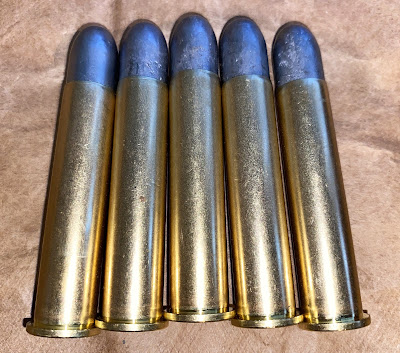 |
| Original M-1881 .45-70-500 cartridge dimensions. |
Introduction
I recently had a conversation about my recreation of the M-1881 .45-70-500 Springfield Trapdoor cartridge and how similar it was (or was not) to the originals, with my interlocutor arguing that the volume of original cases was different from that of modern Starline cases, meaning the powder compaction necessary to load the cartridges was different. This led to the analysis below aimed at determining how close the cartridges actually are to one another. Note that this applies only to the later brass solid head cases used from the 1880’s onward, not to the original copper “folded head” (what today are called “balloon head”) cases.
 |
| Original M-1881 .45-70-500 cartridge. |
 |
| My reproduction M-1881 cartridges. |
I use a SAECO government bullet mold that produces bullets which are very close in design, weight, and dimensions to the originals. I load them over 70 grains of Swiss 2F powder in Starline brass, compacting the powder to a depth of 0.61 in. You can read a detailed explanation of how I load my cartridges, including a link to a video about it, HERE.
Since water has a density of 1 ml./gram, a friend of mine filled an original UMC brass case with water and weighed it, comparing it to a Starline case to determine the volume.
Weight of a UMC solid-head .45-70 case:
Empty: 11.22 grams
W/water: 16.16 grams
Volume: 4.94 ml
Weight of a Starline .45-70 case:
Empty: 12.89 grams
W/water: 17.79 grams
Volume: 4.90 ml
(Courtesy Justin Huzuga, pers. comm. 11JUN2025.)
Difference in Volume: 0.04 ml.
Length of an original 500-grain bullet: 1.31 in.
(1877 Rules of Management p. 43.)
Length of a SAECO 500-grain bullet: 1.29 in.
Difference in Length: 0.02 in.
Analysis
Ordnance Department records say the M-1881 cartridge had a MV (muzzle velocity) of 1,315.7 fps (1887 Rules for Management p. 45), whereas my recreated cartridges have an average MV of 1,315.6 fps—an entirely negligible difference, as are the differences in case volume and bullet length noted above, all within the margin of error. I know from some of Brett Gibbons’ work that Swiss powder produces almost exactly the same MV of British RFG powder, making me think it was extremely similar to the military powder in general of the period. I know the Dupont powder used in the M-1881 cartridges might well be different from the British RFG, but it was, at least, a starting point. I hypothesized that changing the degree of compaction would significantly change the MV, and that if my Swiss 2F was at least close to the Dupont powder and gave the same MV then that would tell me the compression would be about the same. Since the volume of the cases is almost identical, as is the length of the bullets (and hence the depth to which they need to be inserted), this test seems to confirm that Swiss is very similar to Dupont and that the compaction is about the same.
Source:
U.S. Ordnance Department. Rules for the Management of the Springfield Rifle, Carbine, and Army Revolvers. Caliber .45. Washington: Government Printing Office, 1887.




No comments:
Post a Comment